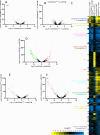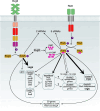Combined transcriptomic and ChIPseq analyses of the Bordetella pertussis RisA regulon
- PMID: 38470037
- PMCID: PMC11019879
- DOI: 10.1128/msystems.00951-23
Combined transcriptomic and ChIPseq analyses of the Bordetella pertussis RisA regulon
Abstract
The regulation of Bordetella pertussis virulence is mediated by the two-component system BvgA/S, which activates the transcription of virulence-activated genes (vags). In the avirulent phase, the vags are not expressed, but instead, virulence-repressed genes (vrgs) are expressed, under the control of another two-component system, RisA/K. Here, we combined transcriptomic and chromatin immunoprecipitation sequencing (ChIPseq) data to examine the RisA/K regulon. We performed RNAseq analyses of RisA-deficient and RisA-phosphoablative B. pertussis mutants cultivated in virulent and avirulent conditions. We confirmed that the expression of most vrgs is regulated by phosphorylated RisA. However, the expression of some, including those involved in flagellum biosynthesis and chemotaxis, requires RisA independently of phosphorylation. Many RisA-regulated genes encode proteins with regulatory functions, suggesting multiple RisA regulation cascades. By ChIPseq analyses, we identified 430 RisA-binding sites, 208 within promoter regions, 201 within open reading frames, and 21 in non-coding regions. RisA binding was demonstrated in the promoter regions of most vrgs and, surprisingly, of some vags, as well as for other genes not identified as vags or vrgs. Unexpectedly, many genes, including some vags, like prn, brpL, bipA, and cyaA, contain a BvgA-binding site and a RisA-binding site, which increases the complexity of the RisAK/BvgAS network in B. pertussis virulence regulation.IMPORTANCEThe expression of virulence-activated genes (vags) of Bordetella pertussis, the etiological agent of whooping cough, is under the transcriptional control of the two-component system BvgA/S, which allows the bacterium to switch between virulent and avirulent phases. In addition, the more recently identified two-component system RisA/K is required for the expression of B. pertussis genes, collectively named vrgs, that are repressed during the virulent phase but activated during the avirulent phase. We have characterized the RisA/K regulon by combined transcriptomic and chromatin immunoprecipitation sequencing analyses. We identified more than 400 RisA-binding sites. Many of them are localized in promoter regions, especially vrgs, but some were found within open reading frames and in non-coding regions. Surprisingly, RisA-binding sites were also found in promoter regions of some vags, illustrating the previously underappreciated complexity of virulence regulation in B. pertussis.
Keywords: Bordetella pertussis; ChIPseq; RNAseq; RisA.
Conflict of interest statement
The authors declare no conflict of interest.
Figures








Similar articles
-
Combined RNAseq and ChIPseq Analyses of the BvgA Virulence Regulator of Bordetella pertussis.mSystems. 2020 May 19;5(3):e00208-20. doi: 10.1128/mSystems.00208-20. mSystems. 2020. PMID: 32430408 Free PMC article.
-
The multifaceted RisA regulon of Bordetella pertussis.Sci Rep. 2016 Sep 13;6:32774. doi: 10.1038/srep32774. Sci Rep. 2016. PMID: 27620673 Free PMC article.
-
The BvgAS Regulon of Bordetella pertussis.mBio. 2017 Oct 10;8(5):e01526-17. doi: 10.1128/mBio.01526-17. mBio. 2017. PMID: 29018122 Free PMC article.
-
The BvgASR virulence regulon of Bordetella pertussis.Curr Opin Microbiol. 2019 Feb;47:74-81. doi: 10.1016/j.mib.2019.01.002. Epub 2019 Mar 11. Curr Opin Microbiol. 2019. PMID: 30870653 Review.
-
Bordetella pertussis from functional genomics to intranasal vaccination.Int J Med Microbiol. 2004 Apr;293(7-8):583-8. doi: 10.1078/1438-4221-00288. Int J Med Microbiol. 2004. PMID: 15149035 Review.
Cited by
-
Genetic and biochemical analyses reveal direct interactions between LitR and genes important for Vibrio fischeri physiology, including biofilm production.J Bacteriol. 2025 Aug 21;207(8):e0004225. doi: 10.1128/jb.00042-25. Epub 2025 Aug 1. J Bacteriol. 2025. PMID: 40748066 Free PMC article.
-
Highlights of the 14th International Bordetella Symposium.mSphere. 2025 Jun 25;10(6):e0018925. doi: 10.1128/msphere.00189-25. Epub 2025 May 16. mSphere. 2025. PMID: 40377335 Free PMC article. Review.
-
Pertussis resurgence: epidemiological trends, pathogenic mechanisms, and preventive strategies.Front Immunol. 2025 Jul 10;16:1618883. doi: 10.3389/fimmu.2025.1618883. eCollection 2025. Front Immunol. 2025. PMID: 40709171 Free PMC article. Review.
References
-
- Dupré E, Herrou J, Lensink MF, Wintjens R, Vagin A, Lebedev A, Crosson S, Villeret V, Locht C, Antoine R, Jacob-Dubuisson F. 2015. Virulence regulation with venus flytrap domains: structure and function of the periplasmic moiety of the sensor-kinase BvgS. PLoS Pathog 11:e1004700. doi:10.1371/journal.ppat.1004700 - DOI - PMC - PubMed
MeSH terms
Substances
Grants and funding
LinkOut - more resources
Full Text Sources
Medical

